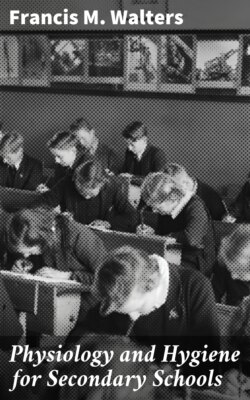Читать книгу Physiology and Hygiene for Secondary Schools - Francis M. Walters - Страница 5
На сайте Литреса книга снята с продажи.
PRACTICAL WORK
ОглавлениеTable of Contents
To demonstrate the Physical Properties of Blood (Optional).—Since blood is needed in considerable quantity in the following experiments, it is best obtained from the butcher. To be sure of securing the blood in the manner desired, take to the butcher three good-sized bottles bearing labels as follows:
1 Fill two thirds full. While the blood is cooling, stir rapidly with the hand or a bunch of switches to remove the clot.
2 Fill two thirds full and set aside without shaking or stirring.
3 Fill two thirds full and thoroughly mix with the liquid in the bottle.
Label 3 must be pasted on a bottle, having a tight-fitting stopper, which is filled one fifth full of a saturated solution of Epsom salts. The purpose of the salts is to prevent coagulation until the blood is diluted with water as in the experiments which follow.
Experiments.—1. Let some of the defibrinated blood (bottle 1) flow (not fall) on the surface of water in a glass vessel. Does it remain on the surface or sink to the bottom? What does the experiment show with reference to the relative weight of blood and water?
2. Fill a large test tube or a small bottle one fourth full of the defibrinated blood and thin it by adding an equal amount of water. Then place the hand over the mouth and shake until the blood is thoroughly mixed with the air. Compare with a portion of the blood not mixed with the air, noting any difference in color. What substance in the air has acted on the blood to change its color?
3. Fill three tumblers each two thirds full of water and set them in a warm place. Pour into one of the tumblers, and thoroughly mix with the water, two tablespoonfuls of the blood containing the Epsom salts. After an interval of half an hour add blood to the second tumbler in the[pg 038] same manner, and after another half hour add blood to the third. The water dilutes the salts so that coagulation is no longer prevented. Jar the vessel occasionally as coagulation proceeds; and if the clot is slow in forming, add a trace of some salt of calcium (calcium chloride). After the blood has been added to the last tumbler make a comparative study of all. Note that coagulation begins in all parts of the liquid at the same time and that, as the process goes on, the clot shrinks and is drawn toward the center.
4. Place a clot from one of the tumblers in experiment 3 in a large vessel of water. Thoroughly wash, adding fresh water, until a white, stringy solid remains. This substance is fibrin.
5. Examine the coagulated blood obtained from the butcher (bottle 2). Observe the dark central mass (the clot) surrounded by a clear liquid (the serum). Sketch the vessel and its contents, showing and naming the parts into which the blood separates by coagulation.
To examine the Red Corpuscles.—Blood for this purpose is easily obtained from the finger. With a handkerchief, wrap one of the fingers of the left hand from the knuckle down to the first joint. Bend this joint and give it a sharp prick with the point of a sterilized 'needle just above the root of the nail. Pressure applied to the under side of the finger will force plenty of blood through a very small opening. (To prevent any possibility of blood poisoning the needle should be sterilized. This may be done by dipping it in alcohol or by holding it for an instant in a hot flame. It is well also to wash the finger with soap and water, or with alcohol, before the operation.) Place a small drop of the blood in the middle of a glass slide, protect the same with a cover glass, and examine with a compound microscope. At least two specimens should be examined, one of which should be diluted with a little saliva or a physiological salt solution.16 In the diluted specimen the red corpuscles appear as amber-colored, circular, disk-shaped bodies. In the undiluted specimen they show a decided tendency to arrange themselves in rows, resembling rows of coins. (Singly, the corpuscles do not appear red when highly magnified.)
A few white corpuscles may generally be found among the red ones in the undiluted specimen. These become separated by the formation[pg 039] of the red corpuscles into rows. They are easily recognized by their larger size and by their silvery appearance, due to the light shining through them.
To examine White Corpuscles.—Obtain from the butcher a small piece of the neck sweetbread of a calf. Press it between the fingers to squeeze out a whitish, semi-liquid substance. Dilute with physiological salt solution on a glass slide and examine with a compound microscope. Numerous white corpuscles of different kinds and sizes will be found. Make sketches.
To prepare Models of Red Corpuscles.—Several models of red corpuscles should be prepared for the use of the class. Clay and putty may be pressed into the form of red corpuscles and allowed to harden, and small models may be cut out of blackboard crayon. Excellent models can be molded from plaster of Paris as follows: Coat the inside of the lid of a baking powder can with oil or vaseline and fill it even full of a thick mixture of plaster of Paris and water. After the plaster has set, remove it from the lid and with a pocket-knife round off the edges and hollow out the sides until the general form of the corpuscle is obtained. The models may be colored red if it is desired to match the color as well as the form of the corpuscle.
